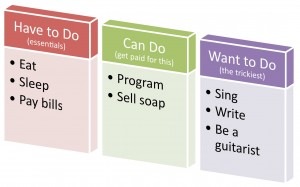
In general, things you do in life fall into 3 categories:
- Things you Have to Do
- Things you Can Do
- Things you Want to Do
Things you Have to Do include your basic necessities – eating, sleeping, earning to provide your rent and pay your bills, and in cases when you are especially in love, providing for your girlfriend or wife.
Things you Can Do are those someone would be willing to pay you for. For example, if you “can do” programming, a company might hire you to work for them. This is what the world perceives you as, and is thus ready to pay you for that. But you might not necessarily want to do that, or even have to do that.
Things you Want to Do are more tricky to understand. This is because we constantly keep changing our mind about what we want to do. First we think of becoming a singer, then a drummer, and then because we see a girl getting patao-fied by a guitarist, we decide that we want to be a guitarist. Overall, we are extremely fickle-minded and can never decide what we want to do.
Now here is the principle of maximizing your career potential:
3/3: A person, in order to be happy and successful in his career, should do those things which fall in all 3 categories.
2/3: In general, that is difficult – so a person should aim to do things which fall in at least 2 of these categories.
1/3: Most people who are unhappy about their careers do things which fall in only 1 of these categories. They should quickly move to increase their career fulfillment score.
This is the 3-by-3 rule – a very simple measure which anyone can use. Let us now explain with more examples:
3/3
Usually achieving this state is very difficult and only 5% of people achieve this. If you achieve this, you will attain the state of ultimately happy – and will be professionally and personally happy.
2/3
If you work as a programmer in a company and are getting paid for it, you satisfy 2 out of 3 categories:
- Have to Do: YES, because you have to earn.
- Can Do: YES, because you have the training for it

But maybe you do not want to do this all your life. Then your score remains at 2/3, and you could attain even higher career satisfaction and fulfillment if you did (and got paid for) something which you were passionate about.
1/3
Many people choose engineering or science because that is the trend. Then after passing a few exams by cramming/copying/managing, they realize that they “can do” it. But they do not have to do it, neither do they want to do it. This is a bad situation.
With these examples, you can now:
- Apply this to your current career scenario. See if your career score is 1/3, 2/3 or 3/3.
- If your career score is 2/3, maybe you “want to” do something else. Start putting some hours of work each week into your “want to do” thing. Maybe you will need to take some training – only then will you move your “want to do” to a “can do” status.
- If your career score is 1/3, do something fast!
- If your career score is 3/3, contact me and I will take your interview!
“The 3-by-3 principle of maximizing career potential” was formulated by Arunabh Kumar and explained in his talk at TEDxIITKgp 2011 (embedded below). It is just restated here and with some additional comments from the post author (but mostly transcribed directly from the talk). The term “3-by-3 principle was coined by the author.
http://www.youtube.com/watch?v=Mb3Z6NhavS8
For those who “want to do” something
Once you have identified the areas which you “want to do” work on, the next step is how to gain more expertise on it. This is another difficult task – but it is definitely not an impossible task. Many people identify the tasks they want to do, but they do not take any action on it. That gets you nowhere.
There is a vast array of resources for learning anything. There are conventional resources like books, people, Professors, alumni networks. Then there is the Internet. Almost anything and everything can now be learned today. The problem usually is that we are basically a lazy community of people – we only need to step out of our usual cyber-haunts like Facebook to visit some sites which will aid our learning.
